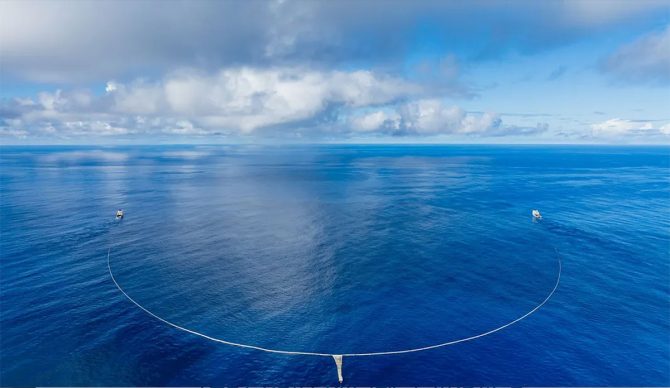
A simple design, but so, so complicated. Photo: The Ocean Cleanup
Boyan Slat has never been afraid to dream big. His mission in life is to rid the world of as much plastic pollution as he can, and he’s doing it through aptly-named The Ocean Cleanup. The last few years have been almost a proof-of-concept deal, abut now, after six years of tinkering and three years of testing, Slat and his team have been able to make a prediction of both cost and time to rid the Pacific Ocean of its infamous garbage patch.
“Over the past three years, The Ocean Cleanup has removed more than one million pounds of trash from the Great Pacific Garbage Patch, or 0.5 percent of the total accumulated trash,” the team wrote in a release. “The data and modeling of these and future operations conclusively prove that the problem is solvable within a decade and could be done in 5 years at a cost of $4bn.”
At today’s level of performance, they could completely clean the Great Pacific Garbage Patch (GPGP) in about a decade for a cost of $7.5 bn, but if they’re able to ramp up operations to higher levels, that 5 year/$4bn target is within reach.
While $4-$7.5 billion may sound like a lot — and indeed it is a lot — it pales in comparison to how costly the GPGP is. “Ocean plastic pollution is one of the most urgent problems our oceans face today, costing the world up to $2.5 trillion per year in damage to economies, industries, and the environment,” the team explained. “Today, we call upon the world to join us in a time for action – the cost of inaction is catastrophic to marine ecosystems, human health, and the environment.”
It’s been six years since The Ocean Cleanup first set sail from San Francisco, dragging its array behind it. The technology Slat’s team created works to extract plastic from ocean gyres, which area areas where the currents bring together all manner of flotsam and jetsam we dump into our seas every day. It’s not quite so easy as simply skimming the plastic off the surface of the ocean, because much of it is broken down into tiny bits that enter the food chain. Some bits float lower in the water column, too, and dragging the sea’s surface and the few feet beneath it means killing untold amounts of sea life, too. But The Ocean Cleanup tackled that head on.
Slat’s design for collecting trash first came to him when he was still a teenager in 2013. Five years later, in 2018, the first prototype was launched. System 001 showed the team what they needed to work on, and after one more iteration — System 02, as you’d expect — System 03 appeared to have the kinks worked out. Next year, the team has decided to take a little break, but not to vacation.
“In 2025, The Ocean Cleanup will take a one-year operational hiatus in order to deploy a new hotspot hunting initiative designed to map the ‘hotspots,'” they wrote, “or areas of intense plastic accumulation in the GPGP, making extractions more impactful.”
For his part, Slat is happy that all his hard work has been proven to be effective.
“Today’s announcement is clear: clean oceans can be achieved in a manageable time and for a clear cost,” he said. “Through the hard work of the past 10 years, humanity has the tools needed to clean up the ocean. We have shown the world that the impossible is now possible. The only missing thing is who will ensure this job gets done. We call upon the world to relegate the Great Pacific Garbage Patch to the history books. This environmental catastrophe has been allowed to exist, unresolved, for too long, and for the first time, we can tell the world what it costs, what is needed and how long it could take. It is time for action.”

